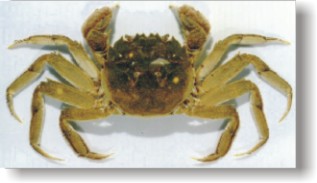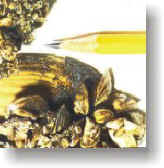|
CURRENT
LIST OF INJURIOUS WILDLIFE SPECIES
(compiled from 50
CFR 16.11-16.15, 10/1/2002.)
Injurious
Wildlife Species Rulings available on the Web:

Mitten Crab
Invasive
species are infiltrators that invade ecosystems beyond their
historic range. Their invasion threatens native ecosystems
or commercial, agricultural, or recreational activities dependent
on these ecosystems. They may even harm the health of humans.
Humans have assisted
with this invasion for centuries. This assistance has been
either intentional or unintentional. Intentional introductions
involve the deliberate transfer of invasive species into native
ecosystems. An example of this would be someone who disposes
the contents of their home aquarium into a waterway. Unintentional
introductions occur when invasives are transferred through
accidental means. For instance, one of the ways that zebra
mussels have spread is through ship ballast water, which is
used to keep ships stable in the water.
Invasives are transferred
through numerous vectors including ships, boats, barges, aquaculture,
agriculture, nurseries, or connected waterways. Through these
and other vectors, thousands of invasive species have been
introduced into this country, costing the economy billions
annually.
Who
are These Invaders?
They cover a wide variety
of species ranging from microscopic plankton to 8-foot tall
purple loosestrife. Other examples include the zebra mussels,
European green and mitten crabs, hydrilla, Eurasian water
milfoil, water lettuce, nutria, sea lamprey, big head carp,
salt cedar, and New Zealand mud snail. Some of these organisms
seem to have little impact on native ecosystems and human
activities while others have devastating effects. The following
provides a few examples of these unwanted guests.

Purple Loosestrife
Zebra mussels have inflicted
tremendous damage to native ecosystems and to facilities using
surface water. A direct correlation exists between an increase
of zebra mussel populations and a decrease in native mussels.
Millions of dollars have been spent by surface water users,
like power plant and municipal water suppliers, to control
and eradicate zebra mussels.

Native Mussel Covered with Zebra Mussels
The European green crab
invaded eastern North America in the early 1800s. It was discovered
in California between 1989 and 1990. It probably entered the
east by boats and the west in packing material of bait shipments
to California. Females can produce 200,000 eggs annually.
The European green crab has damaged New England’s soft
shell clam industry. New England snails have made evolutionary
changes to their shells due to predation by the crab. Because
they eat mussels, clams, snails, worms, barnacles, algae,
isopods and other crustaceans, they could damage commercially
important Dungeness crab, oyster, and clam fisheries on the
west coast.
Eurasian water milfoil
is from Europe, Asia, and northern Africa. In 1942, it was
found in a pond in Washington, D.C., and has spread throughout
much of the U.S. by the aquarium trade, fishermen, and boaters.
Eurasian milfoil out competes native vegetation in lakes,
ponds, and reservoirs, thus providing a less nutritious diet
for waterfowl. Eurasian water milfoil also supports fewer
invertebrates that fish eat. Its dense growth impedes water
flow and clogs water intakes.

Eurasian Water Milfoil
The
Response
The National Invasive
Species Act (NISA) was passed in 1996 amending the Nonindigenous
Aquatic Nuisance Prevention and Control Act of 1990. The 1990
Act established the Aquatic Nuisance Species (ANS) Task Force
to direct ANS activities annually. The Task Force is co-chaired
by the U.S. Fish and Wildlife Service (Service) and the National
Oceanic and Atmospheric Administration. Other members include
the National Marine Fisheries Service, Environmental Protection
Agency, Department of Agriculture, the U.S. Coast Guard, the
U.S. State Department, and the Army Corps of Engineers. NISA
furthered ANS activities by calling for ballast water regulations,
the development of State management plans and regional panels
to combat the spread of ANS, and additional ANS research.
In 1999, President Clinton
signed the Executive Order on Invasive Species. This Order
established an Invasive Species Council, which will oversee
activities of existing organizations that address invasive
species. However, even though many current activities combat
the invasive species, their negative impact on this country’s
resources has been recognized for years.
The Lacey Act was passed
in 1900 and has since been amended to restrict importation,
acquisition, and possession of wildlife deemed injurious.
Wildlife are considered injurious if their importation could
impact negatively on agriculture, horticulture, forestry,
the health and welfare of humans, and the welfare and survival
of wildlife and wildlife resources in the U.S.
The Service’s Fisheries
Program, through its Division of Fish and Wildlife Management
Assistance, supports the implementation of these Acts and
the Executive Order through its Invasive Species Program (Program).
This program provides national leadership preventing, eradicating,
and controlling invasive species.
The Program provides
funding for ANS Task Force personnel and numerous Task Force
activities. It also funds seven FWS regional coordinators
and their respective invasive species activities. These coordinators
work closely with the public and private sector to develop
and implement invasive species activities. Many of the Service’s
fishery resources offices also provide support for invasive
species activities.
The priorities of the
Program are as follows:
- Increase public awareness
of invasive species issues through education and outreach
programs.
- Coordinate aquatic
nuisance species (ANS) management activities with other
Federal and State agencies and private entities.
- Provide technical
assistance for controlling ANS on Federal lands.
- Coordinate and conduct
research activities.
- Through the regulatory
process, prevent the importation of nonindigenous nuisance
species.
Increase
public awareness of nonindigenous nuisance species issues
through education and outreach programs.
This is perhaps the most
important priority. If the spread of nonindigenous nuisance
species is prevented by an informed public, then efforts to
control or eradicate ANS will require fewer resources.
The ANS coordinators
conduct numerous workshops and meetings as a means to educate
and inform the public about ANS. Workshops target important
issues such as State ANS plan development preventing
spread of ANS through the New York Canal System, and
mitten crab impact on the West Coast. Assistance is
provided for national and international meetings.
Coordinators author articles
and provide interviews for national publications and news
programs.
They also attend boating
and sportfishing shows, informing thousands of participants
about the definition, biology, and impacts of ANS and what
they can do to help prevent their spread.
Coordinate
ANS management activities with other Federal and State agencies
and private entities.
One of the premier activities
that numerous ANS coordinators have worked on with public
and private entities is the 100th Meridian Initiative.
The coordinators have worked with the Canadians and other
partners to develop and implement the 100th Meridian
Initiative, which will help prevent the westward spread of
zebra mussels and other ANS by boats and personal watercraft.
Boat inspections and surveys are conducted in 100th
Meridian jurisdictions, including North and South Dakota,
Nebraska, Kansas, Oklahoma, and Texas. Through inspections
and boaters surveys, partners can determine the impact that
transporting boats and personal watercraft has on the spread
of zebra mussels and other ANS and whether boats traveling
west have been in zebra mussel-infested waters.

Zebra Mussel Sightings
The ANS coordinators
organize cooperative sampling efforts with other Federal,
State, and municipal governments, universities, and public
interest groups to track the distribution of ANS such as round
gobies in waters near Chicago. They also assist with integrated
pest management and weed issues, which involves public outreach
and biocontrol risk assessment.
The Division provides
funds to the National Nonindigenous Aquatic Species Information
System in Gainesville, FL. Data in this system are used as
a clearinghouse for ANS information such as maps of sightings,
impacts of ANS, and verification of ANS samples. These data
are easily accessible to the public.
Provide technical
assistance for controlling ANS on Federal lands.
The Service is the steward
of approximately 93 million acres of national wildlife refuge
land. Many nonindigenous nuisance species have made their
home on these refuges. The Fisheries Program support
Fishery Resources Offices which monitor these species on refuges.
The Department of Defense
is required to develop and implement integrated natural resource
management plans for the 25 million acres that it controls.
These plans address prevention and control of nonindigenous
nuisance species. The Fishery Resources Offices review and
assist with the implementation of these plans.
Coordinate
research activities

Ruffe
Ruffe and round goby,
originally from Eurasia, have invaded the Great Lakes.
Fishery Resources Offices in the Great Lakes continuously
work with States and universities to monitor their populations
defining their range of invasion. Sampling equipment used
for monitoring is developed, tested, and refined. The diets
of round gobys are also being studied. For instance, preliminary
analysis indicates that they eat zebra mussels, insect larvae,
and small fish.
The impact of zebra mussels
on native mussels has been studied by fishery resources offices
over the past few years. Zebra mussels are removed from native
mussels before the natives are returned to their habitats.
Zebra mussel populations are monitored.
Sea lamprey, which are
native to the North Atlantic, are established in the Great
Lakes. They have decimated lake trout populations through
their feeding method, in which they attach to fish and extract
their body fluid. As participants in the Great Lakes Fisheries
Commission, the Fishery Resources Offices assist with controlling
sea lampreys. These control methods include testing and applying
lampricide, developing and installing lamprey traps, and stocking
strains of lake trout that may adapt to surviving a sea lamprey
attack. Through these efforts, the battle against sea lamprey
is being won.

Sea
Lamprey
Prevent
the importation of invasive species.
Many invasive species
are imported into this country for various reasons such as
for pets or for the fur trade. These species may escape or
when they are no longer wanted, their owners sometimes release
them into the wild, which can negatively impact native plants
and animals. The Division identifies and researches imports
that could potentially injure native wildlife and wildlife
resources, human health and welfare, agriculture, aquaculture,
horticulture, or forestry. If an import is deemed injurious,
its importation will be denied through the regulatory process.
The
Future
More attention is being
given to invasive species issues. Through the Division’s
programs and the assistance of other Federal and State agencies
and the private sector, invasions of these species can be
reduced and their impact can be minimized. Public knowledge
and participation are key effectively combating these invaders.
Links:
The National Biological Information Infrastructure (NBII).
Current Biological Isssues: Invasive Species (Hosted
by the U.S. Department of Agriculture, this web site is
a gateway to Federal efforts concerning invasive species.)
- http://www.invasivespecies.gov/
U.S. Department of Interior, The Aquatic Nuisance Species
Task Force (an intergovernmental organization
dedicated to preventing and controlling aquatic nuisance
species) - http://anstaskforce.gov/
U.S. Fish and Wildlife Service, National Wildlife Refuge
System. Invasive Species Program- http://invasives.fws.gov/
Updated: October 1, 2003
|








